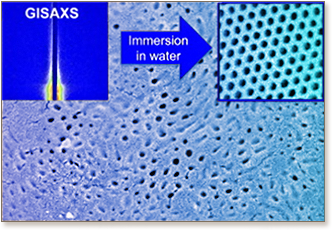Time-resolved GISAXS and cryo-microscopy characterization of block copolymer membrane formation
D.S. Marques, R.M. Dorin, U. Wiesner, D.-M. Smilgies, A.R. Behzad, U. Vainio, K.-V. Peinemann, S.P. Nunes
Polymer (United Kingdom), 55 (6), pp. 1327-1332, (2014)

Time-resolved grazing-incidence small-angle X-ray scattering (GISAXS) and cryo-microscopy were used for the first time to understand the pore evolution by copolymer assembly, leading to the formation of isoporous membranes with exceptional porosity and regularity. The formation of copolymer micelle strings in solution (in DMF/DOX/THF and DMF/DOX) was confirmed by cryo field emission scanning electron microscopy (cryo-FESEM) with a distance of 72 nm between centers of micelles placed in different strings. SAXS measurement of block copolymer solutions in DMF/DOX indicated hexagonal assembly with micelle-to-micelle distance of 84–87 nm for 14–20 wt% copolymer solutions. GISAXS in-plane peaks were detected, revealing order close to hexagonal. The d-spacing corresponding to the first peak in this case was 100–130 nm (lattice constant 115–150 nm) for 17 wt% copolymer solutions evaporating up to 100 s. Time-resolved cryo-FESEM showed the formation of incipient pores on the film surface after 4 s copolymer solution casting with distances between void centers of 125 nm.